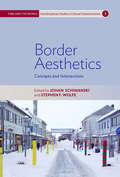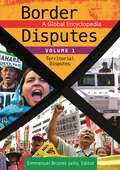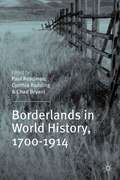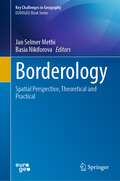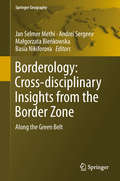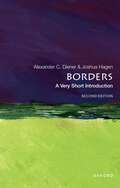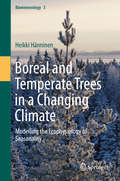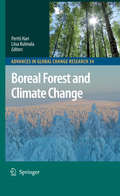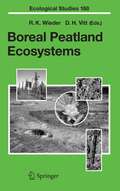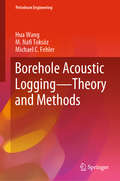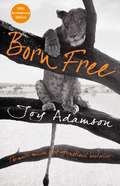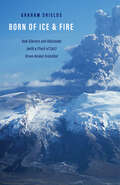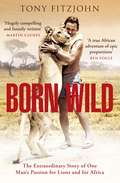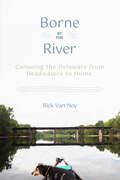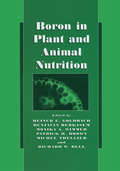- Table View
- List View
Border Aesthetics: Concepts and Intersections (Time and the World: Interdisciplinary Studies in Cultural Transformations #3)
by Johan Schimanski Stephen F. WolfeFew concepts are as central to understanding the modern world as borders, and the now-thriving field of border studies has already produced a substantial literature analyzing their legal, ideological, geographical, and historical aspects. Such studies have hardly exhausted the subject’s conceptual fertility, however, as this pioneering collection on the aesthetics of borders demonstrates. Organized around six key ideas—ecology, imaginary, in/visibility, palimpsest, sovereignty and waiting—the interlocking essays collected here provide theoretical starting points for an aesthetic understanding of borders, developed in detail through interdisciplinary analyses of literature, audio-visual borderscapes, historical and contemporary ecologies, political culture, and migration.
Border Cities and Territorial Development (Regions and Cities)
by Eduardo MedeirosThis monograph analyses the role of border cities in promoting territorial development processes in border regions across the world. It not only embraces the scientific fields of regional and urban studies but also addresses territorial (urban, local, regional) development and planning theories, as well as the effects of development policies applied to border regions in both Europe and North America. In essence, the book offers a full toolkit of border regions' territorial development knowledge and, in particular, advances a range of policy development proposals. It provides a comprehensive introduction to contemporary thinking about how border cities can play a decisive role in boosting territorial development processes in border regions. The book is divided into three parts. Part I presents a theoretical framework on the role of border cities in promoting territorial development and planning in border regions. Part II debates current mainstream policies focusing on supporting border regions and specifically border cities in the EU, the UK, and North America. Finally, Part III presents a wealth of updated knowledge, based on the analysis of several concrete case studies: border cities from both Europe (north, south, east and west) and North America (Canada, the United States, and Mexico). The chapters are written by some of the most renowned authors on the subject, including scholars from several European and North American countries, as well as the secretary generals of three European border regions associations (AEBR, MOT, and CESCI). The book will thoroughly prepare students and provide knowledge to academics and policymakers in the fields of urban and regional planning and development studies, human geography, economic development, EU policies, border regions, and policy impacts.
Border Cities and Territorial Development (Regions and Cities)
by Eduardo MedeirosThis monograph analyses the role of border cities in promoting territorial development processes in border regions across the world. It not only embraces the scientific fields of regional and urban studies but also addresses territorial (urban, local, regional) development and planning theories, as well as the effects of development policies applied to border regions in both Europe and North America. In essence, the book offers a full toolkit of border regions' territorial development knowledge and, in particular, advances a range of policy development proposals. It provides a comprehensive introduction to contemporary thinking about how border cities can play a decisive role in boosting territorial development processes in border regions. The book is divided into three parts. Part I presents a theoretical framework on the role of border cities in promoting territorial development and planning in border regions. Part II debates current mainstream policies focusing on supporting border regions and specifically border cities in the EU, the UK, and North America. Finally, Part III presents a wealth of updated knowledge, based on the analysis of several concrete case studies: border cities from both Europe (north, south, east and west) and North America (Canada, the United States, and Mexico). The chapters are written by some of the most renowned authors on the subject, including scholars from several European and North American countries, as well as the secretary generals of three European border regions associations (AEBR, MOT, and CESCI). The book will thoroughly prepare students and provide knowledge to academics and policymakers in the fields of urban and regional planning and development studies, human geography, economic development, EU policies, border regions, and policy impacts.
Border Disputes [3 volumes]: A Global Encyclopedia [3 volumes]
by Emmanuel Brunet-JaillyAn ideal resource for anyone studying current events, social studies, geopolitics, conflict resolution, and political science, this three-volume set provides broad coverage of approximately 80 current international border disputes and conflicts.Border disputes are a common source of political instability and military conflict around the globe, both in the present day and throughout history. Border Disputes: A Global Encyclopedia will serve as an invaluable resource for students studying social studies, political science, human geography, or related subjects. Each volume of this expansive encyclopedia begins with an accessible introduction to the type of dispute to be discussed, identifying the conflict as territorial (Volume 1), positional (Volume 2), or functional (Volume 3). Following the background essay in each volume are comprehensive case study entries on specific international conflicts, examining the disputed area, the reasons for the dispute, and cultural, political, historical, and legal issues relating to the dispute. The third volume will also provide primary documents of legal rulings and important resolutions of various disputes, as well as profiles of key organizations relating to border studies and specific border dispute commissions.
Border Disputes [3 volumes]: A Global Encyclopedia [3 volumes]
by Emmanuel Brunet-JaillyAn ideal resource for anyone studying current events, social studies, geopolitics, conflict resolution, and political science, this three-volume set provides broad coverage of approximately 80 current international border disputes and conflicts.Border disputes are a common source of political instability and military conflict around the globe, both in the present day and throughout history. Border Disputes: A Global Encyclopedia will serve as an invaluable resource for students studying social studies, political science, human geography, or related subjects. Each volume of this expansive encyclopedia begins with an accessible introduction to the type of dispute to be discussed, identifying the conflict as territorial (Volume 1), positional (Volume 2), or functional (Volume 3). Following the background essay in each volume are comprehensive case study entries on specific international conflicts, examining the disputed area, the reasons for the dispute, and cultural, political, historical, and legal issues relating to the dispute. The third volume will also provide primary documents of legal rulings and important resolutions of various disputes, as well as profiles of key organizations relating to border studies and specific border dispute commissions.
Border Urbanism: Transdisciplinary Perspectives (The Urban Book Series)
by Quazi Mahtab Zaman Greg G. HallBorder Urbanism presents a global array of authors’ research that tackles the perception, interpretation, and nature of borders from a transdisciplinary perspective. The authors examine ways in which borders attempt to define socially, economically, politically, and historically incompatible systems, from micro neighbourhoods to global macro territories, and how this blurs urban order that results in an absence of cohesion. Their analysis of contextual worldwide settings considers the unique issues and the broad scope of forces that shape borders and separate socioeconomic, political, cultural, and historical polarities. The authors consider ways in which the resulting urban border conditions determine the mobility of goods, resources, and people and how these delineations define relationships that influence geopolitical relationships, socioeconomic transactions, and people’s lives at multiple levels. They address the temporal issues defined by a variety of unique urban conditions that result from these lateral thresholds. Each chapter contributes to a critical discourse of the subject of border urbanism and the phenomenon created by separation, demarcation, and segregation as well as by conflict and coexistence. The transdisciplinary approach of Border Urbanism ensures that it will be of interest to individuals across a spectrum of professions and disciplines. Professionals such as urban planners, designers, architects, developers, and civil and environmental engineers and students of these disciplines will be particularly interested as will allied professionals and those not traditionally associated with urbanism; these include artists, sociologists, historians, lawyers, politicians, and civic and government leaders. The authors’ global perspectives, combined with their expertise in environmental, historical, cultural, social, political, and geographic areas, will appeal to anyone interested in border urbanism and its intersection with these areas.
Bordering: Identity Processes between the National and Personal
by Anders Linde-LaursenWhat is a border? This seemingly simple question is here answered via a multidisciplinary study of the cultural, geographic and historic existence of borders, and the ways that they have shaped our world. Using the Danish-Swedish border to illustrate the actions of groups and individuals engaged in bordering since the 1600s, this richly theoretical discussion highlights the complexities of political and cultural identity processes. Comparative perspectives are brought together to produce a thoughtful analysis of how such processes function, and of how borders work on both an imagined nationhood and experiential personal level. The author also examines how throughout history people have lived with and influenced or been influenced by borders, why some borders remain uncontested while others repeatedly provoke cross-border conflicts, and how today's bordering processes may be deliberately manipulated.
Bordering: Identity Processes between the National and Personal
by Anders Linde-LaursenWhat is a border? This seemingly simple question is here answered via a multidisciplinary study of the cultural, geographic and historic existence of borders, and the ways that they have shaped our world. Using the Danish-Swedish border to illustrate the actions of groups and individuals engaged in bordering since the 1600s, this richly theoretical discussion highlights the complexities of political and cultural identity processes. Comparative perspectives are brought together to produce a thoughtful analysis of how such processes function, and of how borders work on both an imagined nationhood and experiential personal level. The author also examines how throughout history people have lived with and influenced or been influenced by borders, why some borders remain uncontested while others repeatedly provoke cross-border conflicts, and how today's bordering processes may be deliberately manipulated.
Borderlands in World History, 1700-1914
by Cynthia Radding Chad Bryant Paul ReadmanCovering two hundred years, this groundbreaking book brings together essays on borderlands by leading experts in the modern history of the Americas, Europe, Africa, Asia and Australia to offer the first historical study of borderlands with a global reach.
Borderlands Resilience: Transitions, Adaptation and Resistance at Borders (Border Regions Series)
by Dorte Jagetic Andersen Eeva-Kaisa ProkkolaThis book offers new insights into the current, highly complex border transitions taking place at the EU internal and external border areas, as well as globally. It focuses on new frontiers and intersections between borders, borderlands and resilience, developing new understandings of resilience through the prism of borders. The book provides new perspectives into how different groups of people and communities experience, adapt and resist the transitions and uncertainties of border closures and securitization in their everyday and professional lives. The book also provides new methodological guidelines for the study of borders and multi-sited bordering and resilience processes. The book bridges border studies and social scientific resilience research in new and innovative. It will be of interest to students and scholars in geography, political studies, international relations, security studies and anthropology.
Borderlands Resilience: Transitions, Adaptation and Resistance at Borders (Border Regions Series)
by Dorte Jagetic Andersen Eeva-Kaisa ProkkolaThis book offers new insights into the current, highly complex border transitions taking place at the EU internal and external border areas, as well as globally. It focuses on new frontiers and intersections between borders, borderlands and resilience, developing new understandings of resilience through the prism of borders. The book provides new perspectives into how different groups of people and communities experience, adapt and resist the transitions and uncertainties of border closures and securitization in their everyday and professional lives. The book also provides new methodological guidelines for the study of borders and multi-sited bordering and resilience processes. The book bridges border studies and social scientific resilience research in new and innovative. It will be of interest to students and scholars in geography, political studies, international relations, security studies and anthropology.
Borderology: Spatial Perspective, Theoretical and Practical (Key Challenges in Geography)
by Jan Selmer Methi Basia NikiforovaThis book develops and establishes knowledge about borderology in the border zone between different countries, cultures, and climatic environment. The content of border and border zone has, during our research, changed from being a physical border between states to different borders and border zones which also include social and mental borders. The COVID-19 pandemic has challenged the concept even more. The expressions “lockdown” and "social distance" indicate such borders that we, a short time ago, had largely not considered in our everyday life. Not only states closed their borders, regions inside a country, and even borders within families were established. “Illegally” passing these borders could crate strong reactions both from the nature by a disease or by the authorities with fees. The pandemic has not only challenged our understanding of borders and border zones, but it has also challenged our understanding of human rights and especially our understanding of what freedom is.
Borderology: Along the Green Belt (Springer Geography)
by Jan Selmer Methi Andrei Sergeev Małgorzata Bieńkowska Basia NikiforovaThis book provides a unique and multifaceted view on and understanding of borders and their manifestations: physical and mental, cultural and geographical, and as a question of life and death. It highlights the Green Belt along the Iron Curtain, which offered a haven for rare species for many decades and, after the Cold War, became a veritable treasure trove for a European network of researchers. A geographical border is something that can be seen, but other borders sometimes have to be crossed to be discovered. The border zone is an arena for development that is not found in any other places. This book focuses on borderology, which became the name of a cross-border study and research program that explores the border zone from multiple perspectives. This cross-disciplinary book will appeal to interested researchers and students from many fields, from philosophy and diplomacy to ecology and geography.
Borders: A Very Short Introduction (VERY SHORT INTRODUCTIONS)
by Alexander C. Diener Joshua HagenFirst published in 2012, Borders: A Very Short Introduction began with the premise that "we live in a very bordered world." The intervening decade has witnessed a flurry of events and developments that continue to highlight the centrality of borders in contemporary domestic and international affairs, as well as the interstices between the two, including sudden surges in migrant and refugees flows; renewed emphasis on traditional border security and wall construction; growing tensions concerning maritime sovereignty; rapid advances in cybersecurity, surveillance, and biometrics; expanded detention and deportation infrastructures; proliferation of transborder organizations; revived populist and nationalist sentiments; and protectionist and integrationist trade practices, to name some prominent examples from recent headlines. This revised edition accounts for recent developments including Brexit, the 2015 migration crisis across Europe, efforts to build a border wall between the US and Mexico, growing isolationist and nativist sentiments, demands for indigenous homelands, transnational protest movements, Russian cross-border incursions, and insurgencies and rebellions across much of North Africa and Southwest Asia.
Borders: A Very Short Introduction (VERY SHORT INTRODUCTIONS)
by Alexander C. Diener Joshua HagenFirst published in 2012, Borders: A Very Short Introduction began with the premise that "we live in a very bordered world." The intervening decade has witnessed a flurry of events and developments that continue to highlight the centrality of borders in contemporary domestic and international affairs, as well as the interstices between the two, including sudden surges in migrant and refugees flows; renewed emphasis on traditional border security and wall construction; growing tensions concerning maritime sovereignty; rapid advances in cybersecurity, surveillance, and biometrics; expanded detention and deportation infrastructures; proliferation of transborder organizations; revived populist and nationalist sentiments; and protectionist and integrationist trade practices, to name some prominent examples from recent headlines. This revised edition accounts for recent developments including Brexit, the 2015 migration crisis across Europe, efforts to build a border wall between the US and Mexico, growing isolationist and nativist sentiments, demands for indigenous homelands, transnational protest movements, Russian cross-border incursions, and insurgencies and rebellions across much of North Africa and Southwest Asia.
Boreal and Temperate Trees in a Changing Climate: Modelling the Ecophysiology of Seasonality (Biometeorology)
by Heikki HänninenThis book provides an overview of how boreal and temperate tree species have adapted their annual development cycle to the seasonally varying climatic conditions. Therefore, the frost hardy dormant phase, and the susceptible growth phase, are synchronized with the seasonality of the climate. The volume discusses the annual cycle, including various attributes such as timing of bud burst and other phenological events, seasonality of photosynthetic capacity or the frost hardiness of the trees. During the last few decades dynamic ecophysiological models have been used increasingly in studies of the annual cycle, particularly when projecting the ecological effects of climate change. The main emphasis of this volume is on combining modelling with experimental studies, and on the importance of the biological realism of the models.
Boreal Forest and Climate Change (Advances in Global Change Research #34)
by Pertti Hari Liisa KulmalaThe Forest Primary Production Research Group was born in the Department of S- viculture, University of Helsinki in the early 1970s. Intensive ?eld measurements of photosynthesis and growth of forest vegetation and use of dynamic models in the interpretation of the results were characteristic of the research in the group. Electric instrumentation was based on analogue techniques and the analysis of the obtained measurements was based on self-written programs. Joint research projects with the Research Group of Environmental Physics at the Department of Physics, lead by Taisto Raunemaa (1939–2006) started in the late 1970s. The two research groups shared the same quantitative methodology, which made the co-operation fruitful. Since 1980 until the collapse of the Soviet Union the Academy of Finland and the Soviet Academy of Sciences had a co-operation program which included our team. The research groups in Tartu, Estonia, lead by Juhan Ross (1925–2002) and in Petrozawodsk, lead by Leo Kaipiainen (1932–2004) were involved on the Soviet side. We had annual ?eld measuring campaigns in Finland and in Soviet Union and research seminars. The main emphasis was on developing forest growth models. The research of Chernobyl fallout started a new era in the co-operation between forest ecologists and physicists in Helsinki. The importance of material ?uxes was realized and introduced explicitly in the theoretical thinking and measurements.
Boreal Peatland Ecosystems (Ecological Studies #188)
by R. K. Wieder D. H. VittThis is the first truly ecosystem-oriented book on peatlands. It adopts an ecosystems approach to understanding the world's boreal peatlands. The focus is on biogeochemical patterns and processes, production, decomposition, and peat accumulation, and it provides additional information on animal and fungal diversity. A recurring theme is the legacy of boreal peatlands as impressive accumulators of carbon as peat over millennia.
Borehole Acoustic Logging – Theory and Methods (Petroleum Engineering)
by Hua Wang M. Nafi Toksöz Michael C FehlerThis book covers the principles, historical development, and applications of many acoustic logging methods, including acoustic logging-while-drilling and cased-hole logging methods. Benefiting from the rapid development of information technology, the subsurface energy resource industry is moving toward data integration to increase the efficiency of decision making through the use of advanced big data and artificial intelligence technologies, such as machine/deep learning. However, wellbore failure may happen if evaluations of risk and infrastructure are made using data mining methods without a complete understanding of the physics of borehole measurements. Processed results from borehole acoustic logging will constitute part of the input data used for data integration. Therefore, to successfully employ modern techniques for data assimilation and analysis, one must fully understand the complexity of wave mode propagation, how such propagation is influenced by the well, and the materials placed within the well (i.e., the cement, casing, and drill strings), and ultimately how waves penetrate into and are influenced by geological formations. State-of-the-art simulation methods, such as the discrete wavenumber integration method (DWM) and the finite difference method (FDM), are introduced to tackle the numerical challenges associated with models containing large material contrasts, such as the contrasts between borehole fluids and steel casings. Waveforms and pressure snapshots are shown to help the reader understand the wavefields under various conditions. Advanced data processing methods, including velocity analyses within the time and frequency domains, are utilized to extract the velocities of different modes. Furthermore, the authors discuss how various formation parameters influence the waveforms recorded in the borehole and describe the principles of both existing and potential tool designs and data acquisition schemes. This book greatly benefits from the research and knowledge generated over four decades at the Earth Resources Laboratory (ERL) of the Massachusetts Institute of Technology (MIT) under its acoustic logging program. Given its scope, the book is of interest to geophysicists (including borehole geophysicists and seismologists), petrophysicists, and petroleum engineers who are interested in formation evaluation and cementation conditions. In addition, this book is of interest to researchers in the acoustic sciences and to 4th-year undergraduate and postgraduate students in the areas of geophysics and acoustical physics.
Borehole Seismology and the Study of the Seismic Regime of Large Industrial Centres (Modern Approaches in Geophysics #2)
by E.I. Galperin I.L. Nersesov R.M. GalperinaAdvances in seismology and extensions of its application have made it increasingly necessary to perform high-sensitivity observationsonartificial earth tremors (explosions) or on natural ones. This implies in particular to investigating the seismic conditions in large industrial centres. There are many major cities with a million inhabitants or more in seismically-active regions. In the USSR, this applies to the capitals of the Union Republics such as Alma Ata, Frunze, Tashkent, Dushanbe, and Ashkhabad, as well as to dozens of local entres and cities with extensive industrial development. Seismic classification and earthquake forecasting have to be considered in relation to the extension or building of cities in such regions, and this would be impossible without detailed investigation of the seismicity, which involves upgrading the instru mental observation network. The demand for detailed information on the seismicity increases with every extension to the construction. A successful solution here can be implemented only by taking account of some specific factors, the main one being the high level of seismic noise due to the activities in large centres, which restricts the sensitivity of the apparatus and makes it impossible to record weak local earth tremors, which are of particular interest in periods of relative seismic calm. Stations at sufficiently great distances from the city do not sense the city noise, but they also fail to record weak local earth tremors. Also, the accuracy ofobservation falls for those tremors that can be recorded because of the great distances between stations.
Born Free: The Story of Elsa (Pan 70th Anniversary #81)
by Joy AdamsonFifty years ago Joy Adamson first introduced to the world the story of her life alongside Elsa the lioness, whom she had rescued as an orphaned cub, and raised at her home in Kenya. But as Elsa had been born free, Joy made the heartbreaking decision that she must be returned to the wild when she was old enough to fend for herself. Since the first publication of Born Free and its sequels Living Free and Forever Free, generations of readers have been enchanted, inspired and moved by these books’ uplifting charm and the remarkable interaction between Joy and Elsa. Millions have also come to know and love Born Free through the immortal film starring Virginia McKenna and Bill Travers. But here is the chance to rediscover the original story in this 50th anniversary edition, in the words of the woman who reared Elsa and walked with the lions.
Born of Ice and Fire: How Glaciers and Volcanoes (with a Pinch of Salt) Drove Animal Evolution
by Graham ShieldsAn exploration of how the Cryogenian Period, when our planet was covered in ice for millions of years, created today’s remarkable biodiversity More than half a billion years ago, our world was completely covered by glaciers, a “Snowball Earth” that persisted for millions of years. Incredibly, this unimaginable cold led to the remarkable diversification of life on earth known as the Cambrian explosion. With a geologist’s eye and a knack for storytelling, Graham Shields explores when and how such inhospitable conditions enabled animals to evolve, radiate, and diversify into our earliest ancestors. This journey navigates the wild swings between hot and cold climates, oxygenation and asphyxiation, biological radiations and extinctions, asking how such instability relates to grander forces that brought our planet to its modern state. Shields guides readers through evidence found in the Australian outback, Mongolia, Scotland, and other locales, revealing how geologists can trace glaciation, the atmosphere, oceans, mountain building, and more through the earth’s rocks, providing a comprehensive theory of how life evolved and diversified.
Born Wild: The Extraordinary Story of One Man's Passion for Lions and for Africa.
by Tony FitzjohnBorn Wild is a story of passion, adventure and skulduggery on the frontline of African conservation. Following Tony Fitzjohn's journey from London bad boy to African wildlife warrior, the heart of the story is a series of love affairs with the world's most beautiful and endangered creatures - affairs that so often end in pain, for to succeed in re-introducing a lion or leopard to the wild is to be deprived of their companionship. Tony tells of his twenty years in Kenya with George Adamson of Born Free fame - a time of discovery, isolation and frequent danger living far from civilisation. And when he was prevented from re-introducing any more animals into the wild and made unwelcome in the country he loved, Tony had to start anew in Tanzania.
Borne by the River: Canoeing the Delaware from Headwaters to Home
by Rick Van NoyAfter a near-fatal stroke and a separation, amidst a global pandemic, Rick Van Noy decided to go for a paddle. In Borne by the River, he charts the story of discovery, and healing that came from this solo canoe journey. Paddling two hundred miles on the Delaware River to his boyhood home just upriver from Trenton, New Jersey, Van Noy contemplates his fate and life, as well as the simple joy of sitting in a small boat floating down a large river with his dog, Sully.Deftly combining memoir, natural and local history, and engaging reportage of his encounters with other paddlers and river enthusiasts, including members of the Lenape Nation of Pennsylvania, Van Noy reveals deep and shifting layers of environmental, historical, cultural, and personal significance of the Delaware. Borne by the River reckons with the way that rivers braid into one's own life—thrilling rapids, eddying pauses, and life-changing rifts and falls. Van Noy rediscovers and shares how river journeys can scatter anxieties, wash away regrets, and recreate the spirit in its free-flowing currents.
Boron in Plant and Animal Nutrition
by Benjavan Rerkasem Monika A. Wimmer Patrick H. Brown Michel Thellier R. W. Bell Heiner E. GoldbachThe Boron '97 meeting was a great success in summarising all recent developments in basic and applied research on boron's function, especially in plants. New techniques have since been developed and new insight has been gained into the role of boron in plant and animal metabolism. Nevertheless, there were still lots of open questions. The aim of the present workshop held in Bonn as a satellite meeting to the International Plant Nutrition Colloquium was thus to gather all actual information which has been gained since the Boron '97 meeting and to compile knowledge, both from animal and plant sciences. Furthermore, applied aspects had to be addressed too, as there is an increasing awareness of boron deficiencies even in crops such as wheat, which have formerly not been considered as responsive to boron application. Genetic differences in boron demand and efficiency within one species are a further important topic which has gained importance since the 1997 meeting. More in-depth knowledge on the mechanisms of boron efficiency are required as an increased efficiency will be one major possibility to maintain and improve crop yields for resource-poor farmers. Nevertheless, it has also clearly been shown that an adequate supply of boron is needed to obtain high yields of crops with a high quality, and that a sustainable agriculture has to provide an adequate boron supply to compensate for inevitable losses through leaching (especially in the humid tropics and temperate regions) and for the boron removal by the crop.
